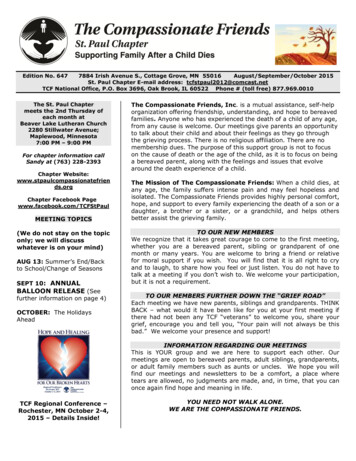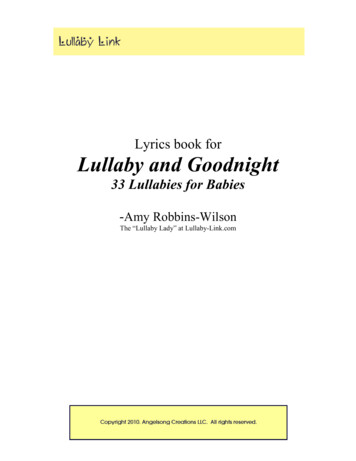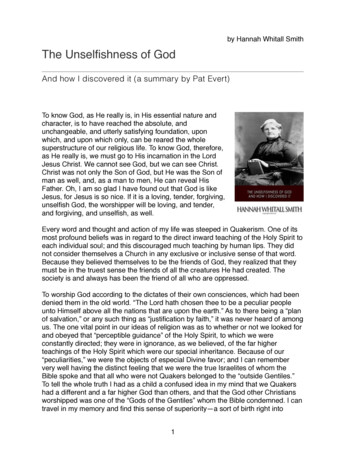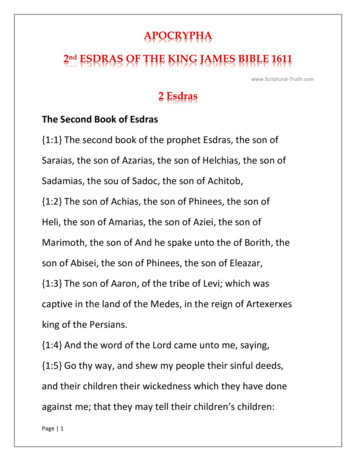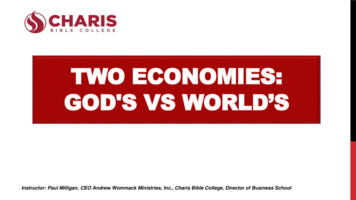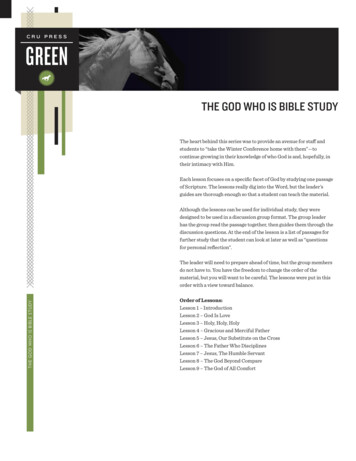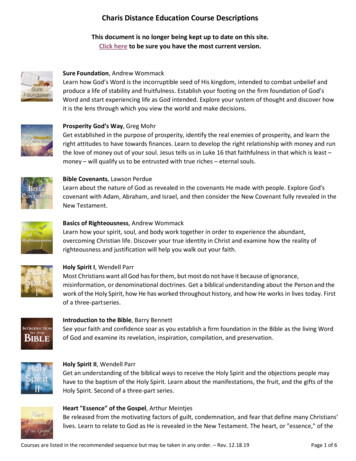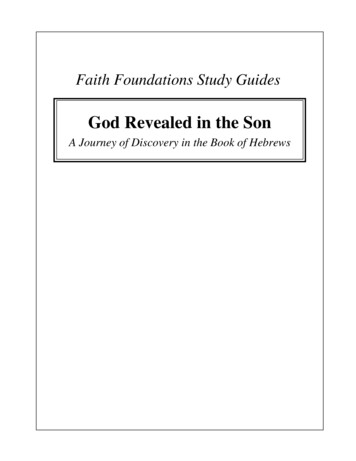
Transcription
Faith Foundations Study GuidesGod Revealed in the SonA Journey of Discovery in the Book of Hebrews
Alan Perkins 2009, 2021All rights reserved. Printed in U.S.A.Scriptures taken from the Holy Bible, New International Version , NIV Copyright 1973, 1978, 1984, 2011 by Biblica, Inc. Used by permission. All rights reserved worldwide.“Biblica”, “International Bible Society” and the Biblica Logoare trademarks registered in the United States Patent and Trademark Officeby Biblica, Inc. Used with permission.
How to Use This BookWelcome to the Faith Foundations study guideon Hebrews! Whether you are just beginning your newlife with Christ, or have been a Christian for manyyears, this study guide is for you. It is designed to helpyou discover, through personal study and groupdiscussion, the incredible riches of God’s Word, andto help you grow in your walk with God by applyingwhat you learn. This book is divided into 26 lessons,each of which contains the full NIV text of theScripture passage, several study and discussionquestions, and a verse-by-verse commentary. So,together with a Bible to look up cross-references,you have everything you need for your "journey ofdiscovery" in Hebrews.Why Small Groups?These materials can be used profitably inpersonal study or in an adult Sunday School class.But their value will be best realized when they areused in small groups, meeting either at churchduring the Sunday School hour or in homes duringthe week. There are several reasons for this.First, no one has perfect insight into everypassage of Scripture; we can all benefit fromhearing the perspectives of other believers as weseek to understand and apply the Bible. A smallgroup gathering, using the discussion questionsincluded in this book, is an ideal way to stimulate asharing of observations and ideas.Second, a small group provides a community offellow travelers who, along with us, are seeking tofollow Christ in the midst of family responsibilities,job pressures, and personal struggles. In today’sfragmented and mobile society, the natural networksof neighborhoods and family no longer provide thesupport they once did. We need some way of makingconnections with others for mutual support, peoplewith whom we can share our joys and sorrows—people who will listen, who will pray with us, whowill offer a helping hand and a word ofencouragement, and who will confront us in lovewhen we’ve gotten off track.Finally, a small group combines the benefits ofBiblical insight and community support by keepingus accountable. If we only study the Scripturesalone, or listen to them taught in a large group, it’seasy to let them go "in one ear and out the other".But when a small group of people are learning thesame things at the same time, they can help oneanother to apply the things they are learning.How Are the Groups Organized?The groups should be composed of 6-14 people:if they are smaller, any absences can make itdifficult to maintain the discussion; if they arelarger, not everyone can participate. You can meetfrom two to four times a month; if the group meetsless than twice a month, the members aren’tspending enough time together to build relationships.Some groups find that meeting three times a monthduring the school year, with a break during thesummer, provides a good rhythm of involvement andtime off.You may choose to include a mix of married andsingle, older and younger members, or you mayorganize your groups by age or marital status.There are benefits to homogeneous groups inwhich the members are going through similar lifeexperiences, but there are also benefits of a diversegroup in which the younger members can benefitfrom the experience of the older.Each group needs to have a recognized leader,preferably one selected and trained by the pastor orchurch leadership. This person’s role during themeeting is not primarily to teach (althoughpreparation of the lesson is a must), but to guide thediscussion and keep the group from getting boggeddown on side issues. He or she does not need to bethe host; in fact, it is preferable that groupresponsibilities, such as providing a home in whichto meet and organizing refreshments, be sharedamong the members.Finally, membership in the group should bebased on three commitments: To prepare for eachmeeting by completing the lesson in advance,which takes from 1/2 to 2 hours (but come to themeeting even if you haven’t done the lesson); toplace a high priority on regular attendance andcome to the meetings except in case of emergency;and to keep confidential anything of a personalnature which is shared during the meetings (exceptwhen it is necessary to communicate concerns tothe pastor).What Is the Group Meeting Like?Each group meeting should last from 1 1/2 to 2hours, and provide time for discussion of thelesson, prayer, and fellowship. A problem in manygroups is for the lesson to take up most of the time,with only a few minutes left over for prayer andfellowship. This must be avoided for the goal ofbuilding relationships to be achieved.Here is a suggested schedule:15 minutes:Gathering30-45 minutes: Discussion of the lesson20-30 minutes: Prayer15-30 minutes: RefreshmentsAs for child care, experience has shown that inorder to receive the maximum benefit from timespent in the meeting, all members of the groupneed to be free to focus on the discussion, ratherthan caring for children. Therefore, with thepossible exception of infants under one year,parents should make arrangements for child careduring the meetings. Some options include"trading" child care with parents whose groupmeets on a different night, having a baby sitter carefor children in another room during the meeting, orproviding child care for all the groups at the church.
Introduction to HebrewsAuthorThe author of this letter is not identified. From thetime of the early church fathers until theReformation, Hebrews was generally consideredto be the work of the apostle Paul, although withreservations. Origen (c. 185-254), noting thedifferences between the elegant Greek ofHebrews and the less polished style of Paul'swritings, wrote that "the thoughts are the apostle's,but . the style and composition belong to onewho called to mind the apostle's teachings and, asit were, made short notes of what his master said."Today, Pauline authorship of Hebrews isalmost universally rejected. The style of Hebrewsis that of a master rhetorician, while Paulacknowledges that he is “untrained as a speaker"(2 Cor. 11:6). The vocabulary of Hebrews isdistinctly non-Pauline: there are over 150 wordsin Hebrews which occur nowhere in Paul'swritings. In addition, Heb. 2:3 states that theauthor received the gospel indirectly from "thosewho heard him [i.e. Christ]", while Paul claims tohave received it directly "by revelation from JesusChrist." (Gal. 1:12).From the letter itself, we know that theauthor was acquainted with Timothy (13:23), andthus presumably one of Paul's associates. Fromhis familiarity with the Jewish traditions andsacrificial system, we conclude that he was aJew; his skillful use of language indicates that hewas an educated Greek. Theories as to hisidentity vary. Martin Luther proposed Apollos,described in Acts 18:24 as a "learned man";Barnabas, Peter, and several others have alsobeen suggested. However, in the end we mustconcur with Origen, who concluded that "whowrote the epistle, in truth God knows."Date and Place of OriginWe have clues to the date of Hebrews in theauthor's references to his readers' pastsufferings, in which they were "publicly exposedto insult and persecution" (10:32-34), and in hisremark that they had "not yet resisted to the pointof shedding your blood" (12:4). It is reasonable tosuggest that the letter was written to those whohad suffered under the expulsion of JewishChristians from Rome by the emperor Claudius inA.D. 49, and who were fearful of the more severepersecution which the Christian community inRome was experiencing at the end of Nero'sreign, A.D. 64-68As to the place from which the letter waswritten, we have no firm internal or externalevidence.Destination and RecipientsHebrews 13:24, which states that "those from Italysend you their greetings," could mean that the letterwas written from Italy. More likely, it indicates thatthe author is in fellowship with Christians who hadleft Italy, perhaps as a result of persecution, andthat he is relaying the greetings of these Italianexpatriates to their countrymen. The most likelydestination in Italy would be Rome, the location ofthe most important church in that area.Several factors indicate that the recipients ofthis letter were predominately, if not exclusively,of Jewish background. The author assumes thatthey share his familiarity with the Old Testamentand with extra-biblical Jewish tradition. Hisinsistence on the superiority of the new covenantover the old, and of the sacrifice and priesthoodof Christ over those of the Jewish ritual system,makes more sense as being addressed to JewishChristians tempted to revert to Judaism thanGentile Christians tempted to revert to paganism.It is probable also that this letter was written,not to an entire church, but to a smallerfellowship, such as a house-church. They arecharacterized as having been Christians for sometime (5:12), which argues against the likelihoodthat they were a large group composed of bothnewer and more experienced Christians. Theauthor's request that they greet "all the Lord’speople" (13:24) also suggests a wider localcommunity outside this group.Occasion and PurposeThis letter is occasioned by a deep crisis of faithin a fellowship of believers with whom the authoris personally acquainted (13:19) and for whom hefeels a pastoral concern and responsibility.Although in the past they had maintained theirconfession in the midst of suffering (10:32-34),they are now being tempted to retreat from theircommitment to Christ; some of them have alreadydone so (3:12, 10:25). Whether the cause of theirspiritual malaise is the prospect of renewedsuffering or just the strain of maintaining their faithin a hostile environment (12:3-7, 13:13), they arein danger of drifting away. They have becomeinattentive to the Scriptures (2:1, 5:11, 12:25), theyare weary and disheartened (12:3, 12) and theirhope is waning (3:6, 6:18-19, 10:23, 11:1).The author's purpose is to encourage,strengthen, and exhort these people to remainfaithful to Christ, in light of the great spiritualresources which they possess in Him, the richrewards of persevering, and the terribleconsequences of shrinking back.SummaryThe author begins by establishing the supremacyof God's self-revelation in his Son, who became aman in order to bring "many sons and daughters toglory" (2:10). He then demonstrates thesupremacy of Christ's priesthood, ministry, andsacrifice to those of the old covenant. Interspersedwith these themes, and concluding the epistle, theauthor warns his readers of the consequences ofinattention and unbelief. He calls them topersevere by fixing their gaze on Christ, imitatingthe great faith heroes of former times, and willinglyenduring suffering, for the sake of the joy to come.
Unit 1 – The Son, God's Ultimate WordHebrews 1:1-4Text1In the past God spoke to our ancestorsthrough the prophets at many times and in variousways, 2 but in these last days he has spoken to usby his Son, whom he appointed heir of all things,and through whom also he made the universe.3The Son is the radiance of God’s glory and theexact representation of his being, sustaining allthings by his powerful word. After he had providedpurification for sins, he sat down at the right handof the Majesty in heaven. 4 So he became asmuch superior to the angels as the name he hasinherited is superior to theirs.Open What activities do you enjoy as an outlet for your creativity?Discover1.As we begin studying Hebrews, it is helpful to have an idea of who it was written to and why it waswritten. From the passages below, what can we learn about the recipients of this letter?vv. 3:1; 6:9-10vv. 2:1; 5:11-12vv. 10:32-342.What does the author tell them which helps to reveal his purpose in writing?vv. 2:18; 4:14-16vv. 3:6-15; 4:11vv. 6:11-12; 12:1-33.In your own words, summarize what you think was the author's purpose in writing Hebrews.
4.This passage compares two kinds of revelation. How are they different?5.How are they similar? (cf. Luke 24:25-27; John 1:45)6.Why is it significant that Hebrews refers to God's revelation as being "spoken"? (cf. 4:12; 12:25)7.This passage contains at least ten truths about the Son (Jesus Christ). List as many as you can identify:8.Paraphrase this statement in your own words: "The Son is the radiance of God's glory and the exactrepresentation of his being."9.How did the Son provide "purification for sins"? (v. 3; see 9:25-26)10. Does your life show that you consider Christ to be superior to everything and everyone else? If youractions show that you regard other things more highly, what are they?Close What is the main point the author is trying tocommunicate in these verses?Which of the statements about Christ in thispassage mean the most to you? What did it cost God to reveal himself tomankind? Why did he do it?
CommentaryAs we begin to study Hebrews, the firstthing we notice is that it opens differentlythan the other New Testament letters. Theauthor does not identify himself or thegroup to whom he is writing, nor does heoffer a prayer for "grace and peace" or givethanks and praise to God.In fact, Hebrews is not written in theform of an ancient letter at all, but isstructured more like a sermon in writing.This judgment is supported by the author'sreference to the book as a "word ofexhortation" (13:22), a standard expressionin his time for a sermon. This is the samephrase which the synagogue rulers inPisidian Antioch use when inviting Paul andBarnabas to speak to the people (Acts13:15, translated "message ofencouragement"), and which Paul useswhen he exhorts Timothy to "the publicreading of Scripture, to preaching, and toteaching" (1Tim. 4:13).Other factors which identify the form ofthis book as a sermon are: (1) a personaltone, as if the author were addressing hisreaders directly; e.g., using the inclusive"we" and addressing them as "brothers andsisters" (3:1,12; 10:19; 13:22); (2)references to speaking and hearing, ratherthan writing and reading (2:5; 5:11; 6:9;8:1; 9:5; 11:32), and (3) the author's formof reasoning, in which he presents abiblical quotation or example, explains it,and applies it to his audience (e.g. 3:7-11;3:12-4:13; 4:14-16).One rhetorical device the author employs isthe use of verbal clues to help the readerfollow the flow of the argument. An exampleof this is the “announcement of the subject”,in which each major division of the book ispreceded by a brief paragraph identifyingthe theme of that section. Here, verses1:1-4 introduce the theme of the largerdivision, 1:1-2:18, which is the revelation ofGod through His Son; specifically, thesupremacy of that revelation to all previousforms of divine self-disclosure.Another device the author uses is chiasticparallelism, in which the first and lastthoughts in a passage are parallel, thesecond and next-to-last are parallel, and soon. Thus, we can diagram vv. 1-4 as follows:Christ superior to the human messengersof God's word (1-2a)Christ appointed heir of all things (2b)The Son the creator of all things (2c)The Son the "radiance of God'sglory" (3a)The Son the "exact representationof his being" (3b)The Son the sustainer of all things (3c)Christ enthroned at God’s right hand (3d)Christ superior to the angelic messengersof God's word (4; see 2:2)vv. 1-2 "In the past God spoke . . . at manytimes and in various ways" Theimplication here is that although therevelation given through the prophets wastruly from God, and in spite of the fact thatit spanned several millennia and tookmany different forms, it was stillincomplete. Only the Son could fullycommunicate God to man.However, the revelation of God in theperson of his Son is not completely distinctfrom that given previously, because theimplicit subject of that revelation was Jesushimself (Lk. 24:25-27; Jn. 1:45). Just as therevelation given through the prophets wasa preparation for God's final self-disclosurein his Son, so the revelation given in theSon was a fulfillment of that previouslygiven through the prophets.Throughout Hebrews, the authoremphasizes the immediacy of God's wordby referring to it as being spoken ratherthan written; it is His voice which we hearin the Scriptures (1:5-13; 3:7; 4:7-8; 5:5-6;7:21; 10:15-17). His word is not somethingwhich belongs to the past, but is even now"living and active" (4:12). Thus, we cannotignore it, but must respond to it as God'smessage for us today (2:1; 3:7; 12:5, 25)."in these last days he has spoken to usby his Son" The contrast between the"past" and "these last days" speaks of achange in eras, and gives us a hint of theeschatological, or future-looking, viewpointof Hebrews. The death, resurrection,and glorification of the Son have set inmotion a series of events which will leadultimately to the consummation of all things,so that we are even now in the "last days".The giving of God's final word, His Son, hasinaugurated the final act of history.This knowledge helps us to perseverein the midst of trials, knowing that, as Paulwrote, "our present sufferings are not worthcomparing with the glory that will berevealed in us" (Rom. 8:18). Thus, we seerepeated references in Hebrews to thethings to come (2:5; 6:20; 10:1,36-37;11:40), and exhortations to hold on untilthe end (3:14; 4:1; 6:11; 10:23; 12:1).When the author tells us that God hasspoken to us "by his Son" he is not speakingmerely of Jesus' words or teachings, but toall that he is and does. Jesus reveals Godby every aspect of his existence: his personand character, his words and works."whom he appointed heir of all things"This is an allusion to Ps. 2:8, in which Godpromises his Son, his Anointed One and King,that he will grant him "the nations" as hisinheritance. Here, the investiture is expandedto include, not only the nations, but all ofcreation (cf. Mt. 11:27; 28:18).
vs. 3"through whom also he made theuniverse" The author now identifies theSon as the agent of creation (cf. John1:3; 1Cor. 8:6; Col. 1:16). Since he is theone by whom the world was brought intoexistence, he is uniquely qualified to actas God's messenger to that world.Another perspective is found in Prov.8:30, in which God's wisdom is spoken ofas the craftsman at his side during thecreation of the world. The joining of theseperspectives implies an identification ofChrist as the personification of the wisdomof God. This connection can also be seen in1 Cor. 1:24, in which Christ is referred to as"the power of God and the wisdom of God,"and in Lk. 11:49 and Mt. 23:34, in whichstatements attributed to the "wisdom ofGod" in Luke (ESV) are attributed to Jesusin Matthew (cf. 1 Cor. 1:30; Col. 2:3)."After he had provided purification forsins" In contrast to the symboliccleansing provided by the ongoing dailysacrifices of the old covenant, the truecleansing from sin accomplished by Christis a single act in the past, which will neverbe repeated (cf. 7:27; 9:12, 25-28).The sacrifice which Christ providedwas his own life, given voluntarilyfor his people (Jn. 10:14-18). His death onthe cross can be viewed in severaldifferent ways, e.g. as appeasing thewrath of God or making payment for sins.Here, it is seen as removing the defilementof sin. Christ's sacrifice is thus thefulfillment of the blood sacrifices of the oldcovenant, which symbolically purged theIsraelites of sin in anticipation of the truesacrifice to come (cf. Lev. 16:19, 30; Rom.3:25; Heb. 10:1-4; 1 Jn. 1:7)."The Son is the radiance of God'sglory and the exact representation ofhis being" These two phrases areparallel. They express the same idea, thatthe Son perfectly communicates God'sessential nature, so that to see and knowhim is to see and know the Father (Jn.12:44-45; cf. Jn. 8:19; 14:6-11). This iswhat Paul meant when he wrote thatChrist is "the image of the invisible God"(Col. 1:15; cf. Jn 1:14, 18; 2 Cor. 4:4).When compared with other NewTestament writings, we see that thisstatement reflects the fundamental unity ofGod the Father and God the Son, and thusthe Son's deity and eternal co-existencewith the Father. So, for example, Paultestifies that Christ is "in very nature God"(Phlp.2:6), and Jesus explicitly declaresthat "I and the Father are one," (Jn. 10:30;cf. Jn. 1:1-2; 17:11, 21-22).The glory of which the Son is theradiance corresponds to the shekinah glorywhich signified the presence of the Lord inthe Old Testament (Ex. 24:15-17; 40:34-38).This description of Christ echoes John'sreference to him as the "light of the world"(Jn. 8:12) and also Jesus' own statementsconcerning the glory he shares with theFather (Jn.17:5, 24). This is the glory whichwas revealed in the transfiguration, whenChrist's "face shone like the sun, and hisclothes became as white as the light"(Mt.17:2), and which was also seen by Paulon the road to Damascus (Acts9:3)."he sat down at the right hand of theMajesty in heaven" This is an allusion toPsalm 110:1, "'Sit at my right hand until Imake your enemies a footstool for yourfeet,'" and refers to the heavenlyenthronement of Christ at the position ofsupreme glory, honor, and power after hisresurrection and ascension (cf. Matt. 26:64;Eph. 1:20; Phlp. 2:9; Col. 3:1; 1 Pet. 3:22;Rev. 5:11-14; also Heb. 8:1; 10:12; 12:2).This is the fulfillment of God's promiseto David that he would place one of hisdescendants upon the throne, and wouldgrant him an everlasting kingdom (cf. Acts2:29-36)."sustaining all things by his powerfulword" Having created the universe, theSon continues to govern and uphold it.The witness which the creation bears to itsCreator (Acts 14:15-17; Rom. 1:19-20) istherefore a revelation of God by the Son.The identification of the Son's "powerfulword" as the means by which he sustainsthe creation links the activity of providencewith the original creation, in which Godspoke all things into being (Gen. 1:1-31).vs. 4 "So he became as much superior to theangels as the name he has inherited issuperior to theirs." This verse serves asa transition into the body of the first majorsection of Hebrews; 1:5-2:18, in which thesuperiority of the Son over the angelic hostis demonstrated. The purpose of thiscomparison is not to combat hereticalteachings concerning the worship of angels(cf. Col. 2:18), but to establish the mainidea of the section, that the new covenant,mediated through Christ, is superior to theold covenant, mediated through angels.The traditional Jewish belief that thelaw was given by angels is shared by theauthor of Hebrews (Heb. 2:2). It is alludedto in the Old Testament (Dt. 33:2) and ismentioned in Stephen's speech to theSanhedrin (Acts 7:53) and in Paul's letterto the Galatians (Gal. 3:19).It seems clear from verse 5 that thebetter "name" which Christ inherited is thatof "Son" (cf. notes on v. 5).Finally, note that in vv. 1-4, the Son isportrayed as fulfilling all three functions ofhis Messianic office: the prophet throughwhom God's final word has come (vv. 2-3),the priest who made purification of sins(v.3), and the king seated at God's righthand (v. 4).
Unit 2 - The Son Superior to AngelsHebrews 1:5-14Text5For to which of the angels did God ever say,10"You are my Son;today I have become your Father a"?Or again,"I will be his Father,and he will be my Son" b?61112And again, when God brings his firstborn intothe world, he says,"Let all God's angels worship him." c7In speaking of the angels he says,13He also says,"In the beginning, Lord, you laid thefoundations of the earth,and the heavens are the work of yourhands.They will perish, but you remain;they will all wear out like a garment.You will roll them up like a robe;like a garment they will be changed.But you remain the same,and your years will never end." fTo which of the angels did God ever say,"Sit at my right handuntil I make your enemiesa footstool for your feet" g?"He makes his angels spirits,and his servants flames of fire." d8But about the Son he says,9"Your throne, O God, will last for ever andever,a scepter of justice will be the scepter ofyour kingdom.You have loved righteousness and hatedwickedness;therefore God, your God, has set youabove your companionsby anointing you with the oil of joy." e14Are not all angels ministering spirits sent toserve those who will inherit salvation?a1:51:5c1:6d1:7e1:9f1:12g1:13bPsalm 2:72 Samuel 7:14; 1 Chron. 17:13Deut. 32:43 (see Dead See Scrolls and Septuagint)Psalm 104:4Psalm 45:6,7Psalm 102:25-27Psalm 110:1Open Are you a handyman (or woman), a "do-it yourself"-er? Or do you have trouble remembering which endof the hammer to hold on to?Discover1. To prepare for this study, it will help to have an understanding of angels. In the space below, summarizewhat these passages teach about them:Their origin (Psalm 148:2-5; Colossians 1:16)Their powers (Revelation 7:1; 14:18; 16:5)Their limitations (Daniel 9:21-23; 1 Pet. 1:10-12)The two kinds of angels (1 Tim. 5:21; 2 Pet. 2:4)The activity of evil angels (Eph. 6:10-12;1 Pet. 5:8)The activity of elect angels:- Psalm 103:20-21; Revelation 5:11-12-Psalm 91:9-13; Hebrews 1:14-Luke 1:26-38, 2:8-14; 24:23-Genesis 19:1, 12-13; Revelation chs. 8-9The attitude we should have toward angels(Colossians 2:18; Revelation 22:9)
2. When Old Testament passages are quoted in Hebrews, the human author is usually not identified(compare Hebrews 1:5-13 with Romans 10:16-21). Why do you think this is?3. Why is Jesus' superiority over angels so important to the author's argument? (see 1:1-2; 2:1-3)4. In what way is Jesus shown to be superior to angels in each of these passages?vv. 5-6vv. 7-12vv. 13-145. In verse 5, Jesus is referred to as God's "Son." Read the Old Testament passages from which thesequotes are taken (Psalm 2 and 2 Samuel 7). What is the main idea of those passages? How do they helpus understand what verse 5 is saying about Christ?6. What characteristics of the Son are emphasized in vv. 8-12? How he is being contrasted with the angels (v. 7)?7. What does verse 13 reveal about the time when all the enemies of Christ will be made subject to him?(see also 1 Cor. 15:20-28)8. What part do angels play in salvation? (v. 14) What do you think this means?Close What about Christ impresses you the most in this passage? How does it affect your motivation to serveand follow him?
CommentaryHaving introduced the theme of the Son'ssuperiority to angels in vv. 1-4, the authornow develops it in vv. 5-14 by appealingto seven passages from the Old Testament,each of which is interpreted with referenceto Christ. This exposition, or explanation ofScripture, is followed in 2:1-4 byexhortation, in which the author applies theScripture to his readers and appeals tothem to respond in faith and obedience.This is the first example of a pattern ofalternating exposition and exhortationwhich is found throughout Hebrews, andwhich reveals the primarily pastoralconcerns of its author.We can discern another pattern bycomparing the statements made about theSon in vv. 2-3 of the previous passagewhich those in vv. 4-15. This pattern is thedevice of synthetic parallelism, in which twopassages present the same or similar ideasin the same sequence. The purpose of thisdevice is to reinforce the repeated ideas inthe mind of the reader or hearer. Thus, wehave Christ's appointment as Son and royalheir in both 2b and 5-9; his role as mediatorof creation in 2c and 10; his eternity andunchanging divine nature in 3a-3b and 1112; and his exaltation to the right hand ofGod in 3d and 13.v. 5and promises him (vs. 8),"I will make the nations your inheritance,the ends of the earth your possession."Psalm 2 was regarded by the Jews ofJesus' day as anticipating the reign of theMessiah ("Messiah" means, literally,"anointed one").The second quote,"I will be his Father, and he will be mySon,"is from 2 Sam. 7:14 (1 Chr. 17:13), apassage in which the prophet Nathanreveals to king David that God would raiseup a successor from his own line, and"establish the throne of his kingdomforever" (2 Sam. 7:13). The immediatereferent of the prophecy was David's sonSolomon, but the Jews expected that itwould ultimately be fulfilled in the reign ofthe Messiah (cf. Jn. 7:42).The author of Hebrews combines theseMessianic prophecies and applies them toJesus Christ. The original contexts of theverses quoted show that the title "Son" isnot being used here to refer to the eternalrelationship between the members of theTrinity (as in Heb. 5:8). Rather, it is acoronation title which refers to Jesus'exaltation and ascension to the throne ofDavid, and his continuing role as king,under God the Father, over all creation."For to which of the angels did God eversay . . . " The wording of this introductoryphrase is identical to that of v. 13. Such arepetition, which signals the beginning andend of a literary unit, is called an inclusio.It is notable that the author of Hebrewsdoes not cite the sources of his quotations.In contrast to other New Testament writers(cf. Rom. 9:15, 25, 27; 10:16, 19, 20; 11:9),he does not identify the human authors orprophets through whom the Scriptures weregiven. Rather, with few exceptions (e.g.,Heb. 4:7; 9:20), he presents the Scripturesas proceeding from God Himself. By doingso, he emphasizes the fact that theauthority of the Scriptures derives from theirdivine origin, and is not enhanced in anyway by the stature of the men God used asHis instruments."You are my Son; today I have becomeyour Father." The two quotations in thisverse are chosen to support the assertionthat Christ is superior to angels because ofthe unique relationship he enjoys with theFather, that of "Son".The first quote is from Psalm 2, in acontext in which the Lord, speaking of his"anointed one," states (vs. 6),"I have installed my Kingon Zion, my
Today, Pauline authorship of Hebrews is almost universally rejected. The style of Hebrews is that of a master rhetorician, while Paul acknowledges that he is “untrained as a speaker" (2 Cor. 11:6). The vocabulary of Hebrews is distinctly non-Pauline: there are over 150 words in

